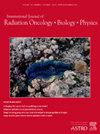应用基于深度学习的面部年龄分型改进接受姑息放疗的转移性癌症患者的预期寿命预测
IF 6.4
1区 医学
Q1 ONCOLOGY
International Journal of Radiation Oncology Biology Physics
Pub Date : 2024-10-01
DOI:10.1016/j.ijrobp.2024.07.034
引用次数: 0
摘要
目的/目标:TEACHH 模型(基于癌症类型、ECOG PS、年龄、既往姑息化疗、住院和肝转移的风险评分)等预后工具旨在预测接受姑息放疗(RT)的转移性癌症患者的预期寿命(LE)。在我们之前的研究中,我们开发了一个通过面部照片预测生物年龄的深度学习模型(FaceAge),该模型显示了预测癌症患者预后的潜力。在此,我们评估了接受姑息性 RT 治疗的患者中 FaceAge 与实际年龄(FaceAge-Age)之间极度不一致的预后意义,并将 FaceAge 应用于 TEACHH 模型。根据患者在 RT 前拍摄的面部照片得出 FaceAge 估计值。Cox和逻辑回归分析分别用于评估总生存期(OS)和早期死亡率(<3个月)的预测因素。在TEACHH模型中,用FaceAge替代了年代年龄,并通过似然比检验(LRT)比较了模型的合适度。55%的患者面部年龄与实际年龄的绝对值相差≥5岁。21%的患者的面部年龄比实际年龄大得多,面部年龄与实际年龄之比≥10岁。在多变量分析中,即使调整了其他重要的预测因素(原发性癌症类型、ECOG PS、化疗和住院治疗),FaceAge-年龄≥10 岁仍与较差的 OS(HR = 1.38,P = 0.01)和 3 个月内早期死亡风险增加(OR = 1.68,P = 0.02)显著相关。对于所有患者,在TEACHH模型中用FaceAge替代chronological age可改善LE组的分层(LRT = 6.1,P <0.01)。在FaceAge与年龄差异≥5年的患者中,TEACHH模型未能显著分层到3个预期的LE组,但用FaceAge替代年龄可显著分层(表;LRT = 7.0,P <0.01)。此外,用 FaceAge 代替生理年龄,可以更准确地捕捉生命末期的生理年龄,从而改善现有生命末期预测模型的性能,尤其是在极度不一致的患者中。这种人工智能生物标志物可能会增强LE预测,并有助于临终治疗决策。本文章由计算机程序翻译,如有差异,请以英文原文为准。
Applying Deep Learning Based Facial Age Phenotyping to Improve Life Expectancy Prediction in Metastatic Cancer Patients Receiving Palliative Radiotherapy
Purpose/Objective(s)
Prognostic tools such as the TEACHH model (risk scoring based on cancer type, ECOG PS, age, prior palliative chemotherapy, hospitalization, and hepatic metastases) aim to predict life expectancy (LE) in metastatic cancer patients receiving palliative radiotherapy (RT). In our prior study, a deep learning model predicting biological age from facial photographs (FaceAge) was developed and showed prognostic potential in cancer patients. Here, we evaluated the prognostic significance of extreme discordance between FaceAge vs chronological age (FaceAge–Age) among patients receiving palliative RT and applied FaceAge to the TEACHH model.
Materials/Methods
A retrospective study of 690 patients with metastatic cancer treated by palliative RT between 2012 and 2018 at six clinic locations was conducted. FaceAge estimates were derived based on patients’ facial photographs taken before RT. Cox and logistic regression analyses were used to evaluate predictors of overall survival (OS) and early mortality (<3 months), respectively. FaceAge was substituted for chronological age in the TEACHH model and model fitness was compared via likelihood ratio test (LRT).
Results
Median OS was 9 months and 41% died within 3 months. Fifty-five percent had ≥ 5 years of absolute difference in FaceAge vs chronological age. Twenty-one percent had a much older FaceAge with FaceAge–Age of ≥ 10 years. In multivariate analyses, FaceAge–Age ≥ 10 years was significantly associated with worse OS (HR = 1.38, P = 0.01) and increased risk of early mortality within 3 months (OR = 1.68, P = 0.02), even after adjusting for other significant predictors (primary cancer type, ECOG PS, chemotherapy, and hospitalization). For all patients, substituting FaceAge for chronological age in the TEACHH model improved LE group stratification (LRT = 6.1, P < 0.01). Among patients with ≥ 5 years of FaceAge vs age discrepancy, the TEACHH model failed to significantly stratify into 3 expected LE groups, but substituting FaceAge for age allowed for significant stratification (Table; LRT = 7.0, P < 0.01).
Conclusion
Extreme discordance in facial aging may be a valuable prognostic marker for metastatic cancer patients receiving palliative RT. Moreover, substituting FaceAge for chronological age improved the performance of an existing LE prediction model, especially in patients with extreme discordance, by more accurately capturing biological age at end-of-life. Such AI biomarker may enhance LE predictions and aid in end-of-life treatment decision making.
求助全文
通过发布文献求助,成功后即可免费获取论文全文。
去求助
来源期刊
CiteScore
11.00
自引率
7.10%
发文量
2538
审稿时长
6.6 weeks
期刊介绍:
International Journal of Radiation Oncology • Biology • Physics (IJROBP), known in the field as the Red Journal, publishes original laboratory and clinical investigations related to radiation oncology, radiation biology, medical physics, and both education and health policy as it relates to the field.
This journal has a particular interest in original contributions of the following types: prospective clinical trials, outcomes research, and large database interrogation. In addition, it seeks reports of high-impact innovations in single or combined modality treatment, tumor sensitization, normal tissue protection (including both precision avoidance and pharmacologic means), brachytherapy, particle irradiation, and cancer imaging. Technical advances related to dosimetry and conformal radiation treatment planning are of interest, as are basic science studies investigating tumor physiology and the molecular biology underlying cancer and normal tissue radiation response.

 求助内容:
求助内容: 应助结果提醒方式:
应助结果提醒方式:


